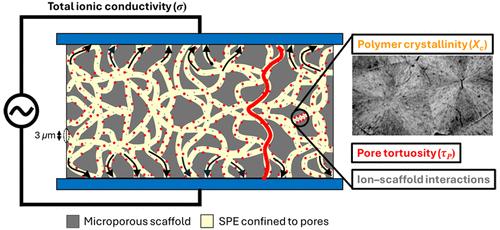当前位置:
X-MOL 学术
›
ACS Macro Lett.
›
论文详情
Our official English website, www.x-mol.net, welcomes your
feedback! (Note: you will need to create a separate account there.)
Effect of Confinement on the Structure–Conductivity Relationship in PEO/LiTFSI Electrolytes in 3D Microporous Scaffolds
ACS Macro Letters ( IF 5.1 ) Pub Date : 2024-11-04 , DOI: 10.1021/acsmacrolett.4c00555 Shreyas Pathreeker, Hyeongjun Koh, Weiwei Kong, Richard Robinson, Gillian Weissman, Eric A. Stach, Eric Detsi, Russell J. Composto
ACS Macro Letters ( IF 5.1 ) Pub Date : 2024-11-04 , DOI: 10.1021/acsmacrolett.4c00555 Shreyas Pathreeker, Hyeongjun Koh, Weiwei Kong, Richard Robinson, Gillian Weissman, Eric A. Stach, Eric Detsi, Russell J. Composto

|
Because 3D batteries comprise solid polymer electrolytes (SPEs) confined to porous scaffolds with high surface areas, the interplay between polymer confinement and interfacial interactions on SPE total ionic conductivity must be understood. This paper investigates contributions to the structure–conductivity relationship in poly(ethylene oxide) (PEO)–lithium bis(trifluorosulfonylimide) (LiTFSI) complexes confined to microporous nickel scaffolds. For bulk and confined conditions, PEO crystallinity decreases as the salt concentration (Li+:EO (r) = 0.0125, 0.0167, 0.025, 0.05) increases. For pure PEO and all r values except 0.05, PEO crystallinity under confinement is lower than in the bulk, whereas the glass transition temperature remains statistically invariant. At 298 K (semicrystalline), total ionic conductivity under confinement is higher than in the bulk at r = 0.0167 but remains invariant at r = 0.05; however, at 350 K (amorphous), total ionic conductivity in confinement is lower than in the bulk for both salt concentrations. Time-of-flight secondary ion mass spectrometry indicates selective migration of ions toward the polymer–scaffold interface. In summary, for the 3D structure studied, polymer crystallinity, interfacial segregation, and tortuosity play important roles in determining total ionic conductivity and, ultimately, the emergence of 3D SPEs as energy storage materials.
中文翻译:

约束对 3D 微孔支架中 PEO/LiTFSI 电解质结构-电导率关系的影响
由于 3D 电池由固体聚合物电解质 (SPE) 组成,这些电解质被限制在具有高表面积的多孔支架中,因此必须了解聚合物约束和界面相互作用对 SPE 总离子电导率的相互作用。本文研究了局限于微孔镍支架的聚(环氧乙烷)(PEO)-双(三氟磺酰亚胺)锂 (LiTFSI) 配合物的结构-电导率关系的贡献。对于块状和受限条件,PEO 结晶度随着盐浓度 (Li+:EO (r) = 0.0125、0.0167、0.025、0.05) 的增加而降低。对于纯 PEO 和除 0.05 之外的所有 r 值,约束下的 PEO 结晶度低于本体,而玻璃化转变温度在统计上保持不变。在 298 K(半结晶)时,约束下的总离子电导率高于 r = 0.0167 处的本体,但在 r = 0.05 处保持不变;然而,在 350 K(无定形)时,两种盐浓度的密闭总离子电导率都低于本体。飞行时间二次离子质谱表明离子向聚合物-支架界面的选择性迁移。总之,对于所研究的 3D 结构,聚合物结晶度、界面偏析和迂曲度在确定总离子电导率以及最终 3D SPE 作为储能材料的出现方面起着重要作用。
更新日期:2024-11-04
中文翻译:

约束对 3D 微孔支架中 PEO/LiTFSI 电解质结构-电导率关系的影响
由于 3D 电池由固体聚合物电解质 (SPE) 组成,这些电解质被限制在具有高表面积的多孔支架中,因此必须了解聚合物约束和界面相互作用对 SPE 总离子电导率的相互作用。本文研究了局限于微孔镍支架的聚(环氧乙烷)(PEO)-双(三氟磺酰亚胺)锂 (LiTFSI) 配合物的结构-电导率关系的贡献。对于块状和受限条件,PEO 结晶度随着盐浓度 (Li+:EO (r) = 0.0125、0.0167、0.025、0.05) 的增加而降低。对于纯 PEO 和除 0.05 之外的所有 r 值,约束下的 PEO 结晶度低于本体,而玻璃化转变温度在统计上保持不变。在 298 K(半结晶)时,约束下的总离子电导率高于 r = 0.0167 处的本体,但在 r = 0.05 处保持不变;然而,在 350 K(无定形)时,两种盐浓度的密闭总离子电导率都低于本体。飞行时间二次离子质谱表明离子向聚合物-支架界面的选择性迁移。总之,对于所研究的 3D 结构,聚合物结晶度、界面偏析和迂曲度在确定总离子电导率以及最终 3D SPE 作为储能材料的出现方面起着重要作用。






























 京公网安备 11010802027423号
京公网安备 11010802027423号